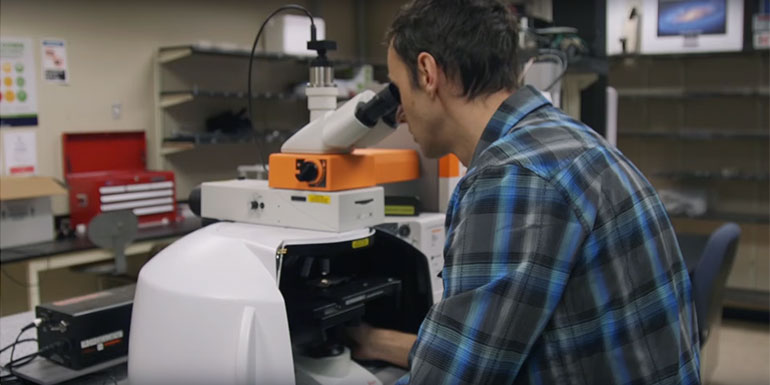
Using a specialized optical technique, called Raman spectroscopy, Andrew Jirasek and colleagues are the first to use the technique to look at the unique cellular changes that occur following radiation.
Infrared fingerprinting of cancer cells can lead to better radiation therapies
Researchers from UBC’s Okanagan campus have discovered a new method of using infrared light to monitor cancer progression during radiation treatment that may lead to better and more personalized therapies.
Cancers are typically treated using a combination of surgery, radiation and chemotherapy. The challenge for physicians is that once a treatment begins, it can last for weeks and usually isn’t adjusted to reflect how the cancer is responding.
“Previous research tells us that patients can be either over- or under-treated with radiation,” says Andrew Jirasek, associate professor of physics at UBC Okanagan and one of the study’s lead authors. “The problem is that even cancers of the same type, like breast cancer, can have different behaviours in individual patients.”
One of the most important behaviours, explains Jirasek, is sensitivity to radiation.
“Our goal was to identify a technique that can monitor a cancer’s sensitivity and response to radiation so that the dose can be adjusted to meet an individual patient’s needs,” says Jirasek. “It turns out that Raman spectroscopy is a minimally invasive means of doing just that.”
Relatively simple to perform and minimally invasive, Raman spectroscopy provides information about a sample of cancer tissue by shining an infrared light on it. Different components within the cells absorb the infrared light at specific wavelengths, creating a cancer ‘fingerprint’.
“The important difference is that as the cancer is exposed to radiation, levels of particular components in the cells will change over time and so too will the spectral ‘fingerprint’,” says Jirasek. “This opens up exciting new opportunities to track the progression in individual patients and personalize their radiation dose.”
While the technique isn’t ready to be applied to cancer patients yet, Jirasek is encouraged by the possibilities.
“We’ve shown that Raman spectroscopy can be an incredibly useful tool in measuring biochemical changes in cancer tissue,” says Jirasek. “Our next step will be to document what kinds of spectral fingerprints correspond to radiation sensitivity or resistance.”
“This could well open up new avenues for more effective and safer personalized medicine.”
The study was published in the journal Radiation Research and is supported by funding from the Canadian Institutes of Health Research, the Canada Foundation for Innovation, Western Economic Diversification, the BC Cancer Foundation and the Natural Sciences and Engineering Research Council.